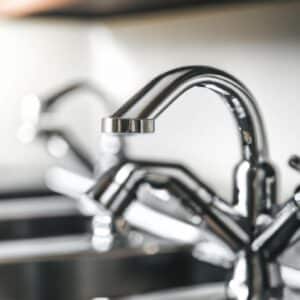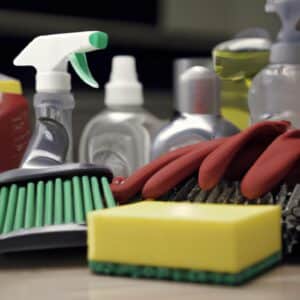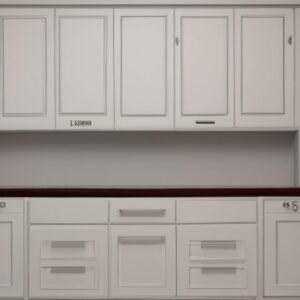Are you frustrated with clogged kitchen sink drains and pipes? Have you tried several attempts to unclog them but failed? You don’t have to call a plumber to get your kitchen sink unclogged. You can easily clean kitchen sink drains and pipes using some of the simplest and most effective techniques. In this guide, I will teach you how to use hot water, white vinegar, garbage disposal, cold water, warm water, boiling water, and food particles to get your kitchen sink drains and pipes unclogged. So, let’s dive right in!
Hot Water & White Vinegar
Unclogging kitchen sink drains and pipes can be a daunting task, especially if the clog is stubborn. However, there are many DIY techniques you can attempt to tackle the problem. One of these methods is to use hot water and white vinegar. This combination is an easy and effective way to quickly unclog your kitchen sink pipes.
First, start by boiling water in a pot on the stove. Then, pour the boiling water down the kitchen sink drain. This will help to loosen any food particles that are causing the blockage. Afterwards, pour a cup of white vinegar down the sink and let it sit for about an hour. The vinegar will help to break down the stubborn food particles that can’t be removed with boiling water. Lastly, pour another pot of boiling water down the drain to flush away the loosened food particles. Follow up with cold water to ensure the pipes are clear. You should now have unclogged kitchen sink drains and pipes.
Garbage Disposal
Using a garbage disposal can be a great way to unclog your kitchen sink drains and pipes. This method is an effective way of dealing with stubborn clogs, soap scum, and food particles. To begin, make sure the disposal is unplugged before you start working on it. Once the disposal is unplugged, you can use a cup of vinegar, baking soda, or a drain cleaner to help with the unclogging process. Then, use a sink drain snake or wire hanger to reach deep into the garbage disposal and remove any clogs. Finally, plug the disposal back in and run cold and warm water through the pipes to flush out the remaining debris and blockage. With these simple steps, you can easily unclog your kitchen sink drains and pipes with the help of a garbage disposal!
Cold Water
Cold water can be an effective way to unclog kitchen sink drains and pipes. The cold temperature helps to solidify and break down food particles and soap that may be blocking your drain. To use cold water to unclog your kitchen sink, first make sure that your sink is completely drained. Then, fill the sink with cold water until it is about halfway full. Let the water sit for a few minutes before turning on the cold water tap and allowing it to drain. Once the water has drained, your sink should be unclogged.
If your cold water method does not work, you can try using warm water. Heat can help to break down soap and food particles that may be blocking your drain. To use warm water to unclog your kitchen sink, first make sure that your sink is completely drained. Then, fill the sink with warm water until it is about halfway full. Let the water sit for a few minutes before turning on the warm water tap and allowing it to drain. After the water has drained, your sink should be unclogged.
Warm Water
Warm water is another effective and straightforward way to unclog kitchen sink drains and pipes. It isn’t as powerful as boiling water, but it is still effective for loosening debris and grime. All you need to do is mix hot and cold water in the sink and let it run for a few minutes before flushing it out. This can help to break down clogs and allow them to run down the drain.
Using warm water is an easy and safe way to remove stubborn clogs from the sink without using chemical cleaners. Just make sure that the water isn’t too hot, as this could damage the pipes. Once the water is warm enough, let it run for a couple of minutes until the clog has been cleared. This should help to remove food particles, soap scum, and other blockages from the sink and pipes.
Boiling Water
Boiling water is an effective and powerful method for unclogging kitchen sink drains and pipes. The heat and pressure of the boiling water can help to break up any grease, soap scum, and food particles that are causing the clog. It is important to note that boiling water should not be used on PVC pipes, as the heat can cause them to warp and become damaged.
To use boiling water to unclog your kitchen sink drains and pipes, start by boiling a pot of water. Once the water is boiling, carefully pour it slowly into the clogged sink or drain. The hot water should help to break up the clog and allow it to flush down the drain. If the drain is still clogged, repeat the process as many times as necessary. You may also want to add a cup of white vinegar to the boiling water to help break up the clog.
After pouring the boiling water down the drain, it may be necessary to use a plunger to help clear the clog. If the clog persists, then it may be necessary to use a drain snake or other tool to remove the clog. Always use caution when using boiling water to unclog a kitchen sink drain or pipe. If you are unsure of what to do, then it is best to contact a professional plumber.
Food Particles
No matter how hard you try to keep it clean, food particles are bound to get stuck in your kitchen sink drains and that can clog them up. It’s important to remove food particles regularly to ensure your kitchen sink drains are unclogged and running smoothly. Here are some tips on how to do it.
Start by using a wire hanger to remove food particles from the sink drain. Insert the hanger as far down the drain as you can, then move it around to grab any debris that is stuck. Once you’ve removed as much as you can with the hanger, use a cup of white vinegar and a cup of baking soda to create a mixture that will help break down the food particles. Pour the mixture slowly down the drain and allow it to sit for 30 minutes.
After the 30 minutes is up, fill the sink with hot water and allow it to sit for a few minutes before flushing it through with cold water. This will help wash away any remaining food particles and help break up any clogs. You can also use a drain snake to help remove any stubborn clogs if needed.
If the food particles aren’t coming loose, consider using a chemical drain cleaner or boiling water to help break up any clogs. Use caution when using these methods and only use them if necessary as they can be dangerous.
By following these steps, you can ensure that your kitchen sink drains and pipes are free of food particles and clogs. With regular maintenance, you can keep your kitchen sink clean and clear for years to come.
Double Sink
Having a double sink in your kitchen can help make unclogging your drains and pipes easier. Not only can you easily access the clog with two sides, but the extra sink can also be used as a container to help catch any debris or food particles that are causing the clog.
Using a double sink to unclog your kitchen sink drains and pipes is relatively simple. First, you’ll need to fill one side of the sink with hot water. Then, add a cup of white vinegar and allow it to sit for 10-15 minutes. Next, turn on the disposal side of the sink and allow the hot water and vinegar mixture to flush through the pipes. Finally, pour cold water into the sink to help rinse away any remaining food particles. This should help to remove the clog and keep your drains running smoothly.
Kitchen Drain
Clogged kitchen sink drains and pipes can often be cleared with the use of a kitchen drain. A kitchen drain is made up of a series of pipes that lead to the main sewer line. If the clog is located in the kitchen drain, a plumber may be required to access the pipes and use a drain snake to clear it.
Fortunately, there are numerous ways to unclog kitchen sink drains and pipes with a kitchen drain. One option is to pour a cup of white vinegar down the kitchen drain. The vinegar will break down the clog and loosen it. After a few minutes, run hot water down the drain to flush out the vinegar and any debris that has been loosened. For more stubborn clogs, you may need to use a drain snake or a chemical cleaner. Be sure to follow the instructions on the cleaner carefully. Additionally, a rolling boil of water can be used to help remove soap scum and other buildup from the pipes.
Drain Snake
If your kitchen sink has a stubborn clog that won’t budge with any other methods, you may need to use a drain snake. A drain snake is a long, flexible rod with a spiral end that is inserted into the clogged drain and used to break up the clog. This method is a great way to get to the bottom of the clog and it can be very effective.
Using a drain snake is not a difficult task, but it does require some care and caution. To begin, make sure the power to the garbage disposal is off. Then, insert the snake into the drain and push it until you feel resistance. Gently move the snake back and forth and twist it as you go. Doing this should break up the clog. Once the clog is broken up, remove the snake and flush the drain with hot water to clear away any remaining debris.





